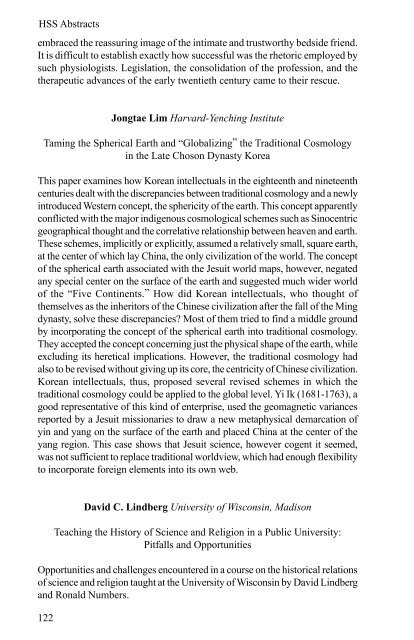2000 HSS/PSA Program 1 - History of Science Society
2000 HSS/PSA Program 1 - History of Science Society
2000 HSS/PSA Program 1 - History of Science Society
Create successful ePaper yourself
Turn your PDF publications into a flip-book with our unique Google optimized e-Paper software.
<strong>HSS</strong> Abstracts<br />
embraced the reassuring image <strong>of</strong> the intimate and trustworthy bedside friend.<br />
It is difficult to establish exactly how successful was the rhetoric employed by<br />
such physiologists. Legislation, the consolidation <strong>of</strong> the pr<strong>of</strong>ession, and the<br />
therapeutic advances <strong>of</strong> the early twentieth century came to their rescue.<br />
Jongtae Lim Harvard-Yenching Institute<br />
Taming the Spherical Earth and “Globalizing” the Traditional Cosmology<br />
in the Late Choson Dynasty Korea<br />
This paper examines how Korean intellectuals in the eighteenth and nineteenth<br />
centuries dealt with the discrepancies between traditional cosmology and a newly<br />
introduced Western concept, the sphericity <strong>of</strong> the earth. This concept apparently<br />
conflicted with the major indigenous cosmological schemes such as Sinocentric<br />
geographical thought and the correlative relationship between heaven and earth.<br />
These schemes, implicitly or explicitly, assumed a relatively small, square earth,<br />
at the center <strong>of</strong> which lay China, the only civilization <strong>of</strong> the world. The concept<br />
<strong>of</strong> the spherical earth associated with the Jesuit world maps, however, negated<br />
any special center on the surface <strong>of</strong> the earth and suggested much wider world<br />
<strong>of</strong> the “Five Continents.” How did Korean intellectuals, who thought <strong>of</strong><br />
themselves as the inheritors <strong>of</strong> the Chinese civilization after the fall <strong>of</strong> the Ming<br />
dynasty, solve these discrepancies? Most <strong>of</strong> them tried to find a middle ground<br />
by incorporating the concept <strong>of</strong> the spherical earth into traditional cosmology.<br />
They accepted the concept concerning just the physical shape <strong>of</strong> the earth, while<br />
excluding its heretical implications. However, the traditional cosmology had<br />
also to be revised without giving up its core, the centricity <strong>of</strong> Chinese civilization.<br />
Korean intellectuals, thus, proposed several revised schemes in which the<br />
traditional cosmology could be applied to the global level. Yi Ik (1681-1763), a<br />
good representative <strong>of</strong> this kind <strong>of</strong> enterprise, used the geomagnetic variances<br />
reported by a Jesuit missionaries to draw a new metaphysical demarcation <strong>of</strong><br />
yin and yang on the surface <strong>of</strong> the earth and placed China at the center <strong>of</strong> the<br />
yang region. This case shows that Jesuit science, however cogent it seemed,<br />
was not sufficient to replace traditional worldview, which had enough flexibility<br />
to incorporate foreign elements into its own web.<br />
122<br />
David␣ C. Lindberg University <strong>of</strong> Wisconsin, Madison<br />
Teaching the <strong>History</strong> <strong>of</strong> <strong>Science</strong> and Religion in a Public University:<br />
Pitfalls and Opportunities<br />
Opportunities and challenges encountered in a course on the historical relations<br />
<strong>of</strong> science and religion taught at the University <strong>of</strong> Wisconsin by David Lindberg<br />
and Ronald Numbers.
















